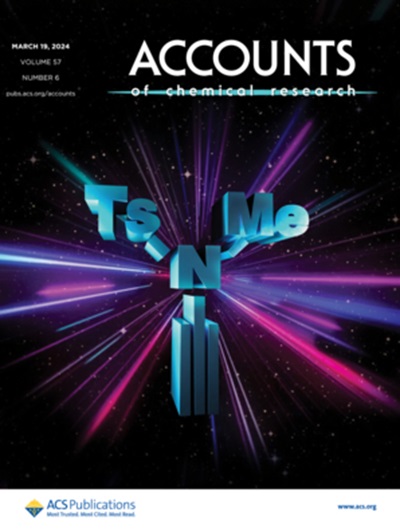Molecular Mechanisms of Virulence Regulation in Staphylococcus aureus: A Journey into Reconstitutive Biochemistry.
IF 17.7
1区 化学
Q1 CHEMISTRY, MULTIDISCIPLINARY
引用次数: 0
Abstract
ConspectusMethodological development in the fields of genetics, chemical biology, and biochemistry over the last several decades has provided researchers with a diverse set of powerful tools to investigate biological processes. Leveraging these innovations in concert, scientists can now characterize biological pathways at a level of complexity ranging from systems biology down to molecular and atomic detail.Throughout this Account, we illustrate how discoveries made using these tools build on each other to develop a comprehensive understanding of biological pathways. Advancements in genetic sequencing facilitates association of genotypes and phenotypes, independent of biochemical mechanism. Through the biochemical reconstitution of the interactions between biological macromolecules─including the small molecules (ligands and metabolites) and proteins─that participate in these biological pathways, scientists can characterize the specific molecular features that link genotype and phenotype. This facilitates identification of targets within these pathways that can be manipulated to achieve a greater understanding of the biological process or to develop interventions to improve human health outcomes.Specifically, we describe how this toolbox was leveraged to discover and characterize the molecular biochemistry underlying control of pathogenicity in the Gram-positive bacterium Staphylococcus aureus. Concurrent with advancements in the investigative tools available to the scientific community, we and others reported on the genetic, molecular, and biochemical/biophysical components of this regulatory system. Virulence control in S. aureus is achieved through a chemical system of bacterial cell-to-cell communication indexed to local population density, referred to as quorum sensing (QS). We and our collaborators identified that this QS system is encoded in the accessory gene regulator (agr) operon and functions via the biosynthesis, secretion, and accumulation of a short peptide signaling molecule─the autoinducing peptide (AIP)─in the local environment correlated with the growth of S. aureus in the same biological niche. Above a threshold concentration, these AIPs bind and activate a cell-surface receptor to stimulate an intracellular response resulting in altered gene expression and bacterial group behaviors. We discovered that chemical modification of these AIPs often generates molecules that exhibit potent inhibition of agr QS, with demonstrated therapeutic potential to treat S. aureus infections. We went on to characterize the biochemical mechanism of signaling molecule biosynthesis and receptor activation in controlled systems through in vitro reconstitution of the constituent enzymes and substrates. Biochemical reconstitution enabled quantitative assessment of biophysical parameters. These efforts culminated in the comprehensive characterization and functional in vitro reconstitution of agr QS in a synthetic system in a minimal model at the interface of genotype, mechanism, and phenotype.金黄色葡萄球菌毒力调控的分子机制:重组生物化学之旅。
在过去的几十年里,遗传学、化学生物学和生物化学领域的方法学发展为研究人员提供了一套多样化的强大工具来研究生物过程。利用这些创新,科学家们现在可以在从系统生物学到分子和原子细节的复杂水平上描述生物途径。在整个叙述中,我们说明了使用这些工具的发现如何相互建立,以发展对生物途径的全面理解。基因测序的进步促进了基因型和表型的关联,独立于生化机制。通过对生物大分子(包括参与这些生物途径的小分子(配体和代谢物)和蛋白质)之间相互作用的生化重构,科学家们可以表征连接基因型和表型的特定分子特征。这有助于确定这些途径中的目标,这些目标可以通过操纵来更好地了解生物过程或制定干预措施以改善人类健康结果。具体来说,我们描述了如何利用这个工具箱来发现和表征革兰氏阳性细菌金黄色葡萄球菌致病性控制的分子生物化学。随着科学界可用的调查工具的进步,我们和其他人报道了这个调节系统的遗传、分子和生化/生物物理组成部分。金黄色葡萄球菌的毒力控制是通过细菌细胞间通讯的化学系统来实现的,该系统与当地种群密度有关,称为群体感应(quorum sensing, QS)。我们和我们的合作者发现,这个QS系统是在辅助基因调控(agr)操纵子中编码的,并通过生物合成、分泌和积累短肽信号分子──自动诱导肽(AIP)──在与金黄色葡萄球菌在同一生物生态位中的生长相关的局部环境中发挥作用。超过阈值浓度,这些AIPs结合并激活细胞表面受体,刺激细胞内反应,导致基因表达和细菌群体行为改变。我们发现,这些AIPs的化学修饰通常会产生对agr QS具有有效抑制作用的分子,具有治疗金黄色葡萄球菌感染的治疗潜力。我们继续通过体外重组组成酶和底物来表征信号分子生物合成和受体激活在受控系统中的生化机制。生化重构使生物物理参数的定量评估成为可能。这些努力最终在基因型、机制和表型界面的最小模型合成系统中对agr QS进行了全面的表征和体外功能重构。
本文章由计算机程序翻译,如有差异,请以英文原文为准。
求助全文
约1分钟内获得全文
求助全文
来源期刊

Accounts of Chemical Research
化学-化学综合
CiteScore
31.40
自引率
1.10%
发文量
312
审稿时长
2 months
期刊介绍:
Accounts of Chemical Research presents short, concise and critical articles offering easy-to-read overviews of basic research and applications in all areas of chemistry and biochemistry. These short reviews focus on research from the author’s own laboratory and are designed to teach the reader about a research project. In addition, Accounts of Chemical Research publishes commentaries that give an informed opinion on a current research problem. Special Issues online are devoted to a single topic of unusual activity and significance.
Accounts of Chemical Research replaces the traditional article abstract with an article "Conspectus." These entries synopsize the research affording the reader a closer look at the content and significance of an article. Through this provision of a more detailed description of the article contents, the Conspectus enhances the article's discoverability by search engines and the exposure for the research.
 求助内容:
求助内容: 应助结果提醒方式:
应助结果提醒方式:


